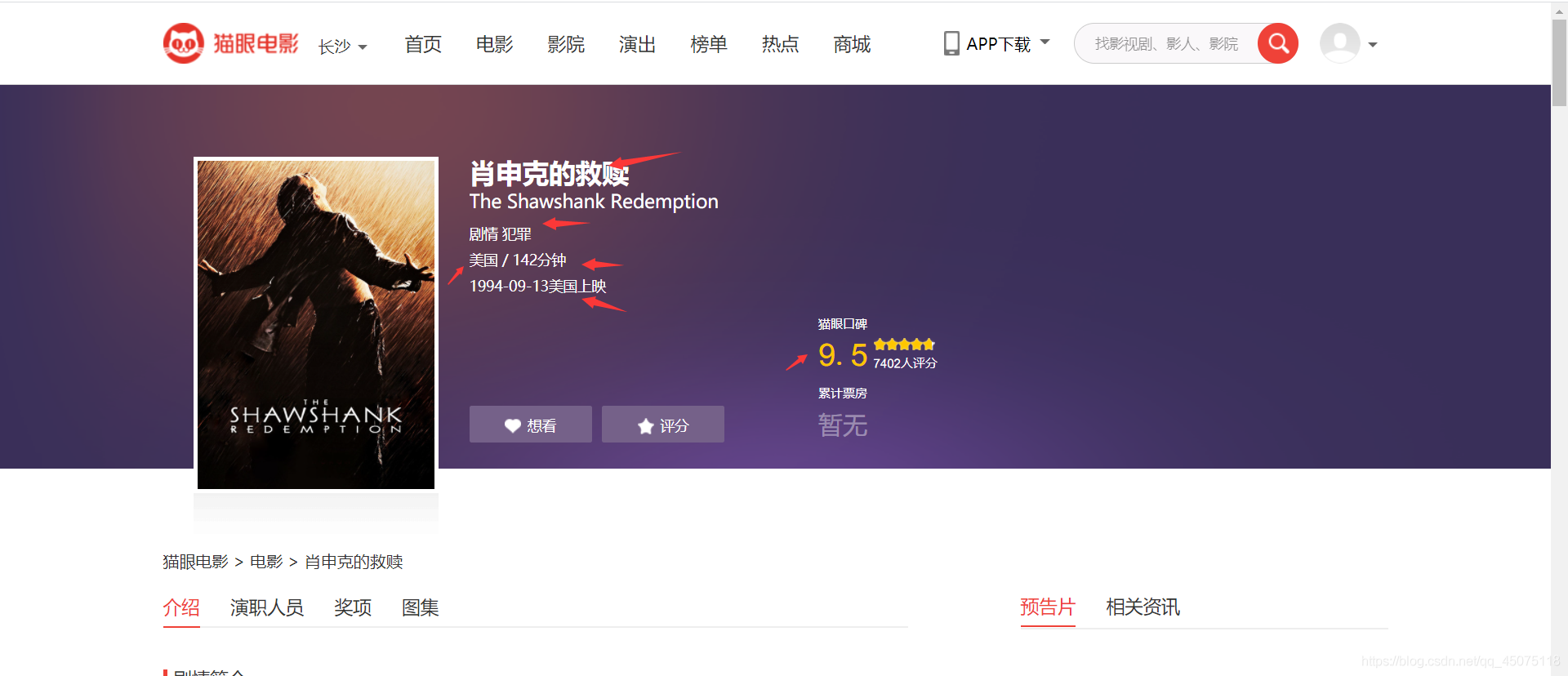记录一次真实的接单记录:猫眼电影数据可视化,三个小时完成收入1000
上周末接到一个单1200,客服抽了百分之十的提成,到手1000,两个小时就完成了,心里美滋滋的,这样的单其实平常不多,技术难度低但是价格高,我们俗称“捡鱼单”。想着赚钱了请女神吃饭,竟被无情拒绝!

数据来源: 猫眼电影
开发环境:win10、python3.7
开发工具:pycharm、Chrome
首先将猫眼电影的所以的电影信息采集下来
这里以猫眼的top100榜为例
获取到电影信息:
- 电影名称
- 电影评分
- 电影链接
- 电影类型
- 电影上映地点
- 地点
- 电影时长
- 电影时长

解析网页数据信息
解析首页的跳转链接
猫眼详情页面的评分是有加密的,所以我们直接重主页提取评分信息
在详情页面提取数据
将数据保存在csv表格,方便之后做数据可视化
import pandas as pd
import numpy as np
import jieba
from wordcloud import WordCloud
import matplotlib.pyplot as plt
# get_ipython().run_line_magic('matplotlib', 'inline')






#!/usr/bin/env python
# -*- coding: utf-8 -*-
# @Time : 2021年06月05日
# @File : demo4.py
import requests
from fake_useragent import UserAgent
from lxml import etree
import time
# 随机请求头
ua = UserAgent()
# 构建请求 需要自己去网页上面换一下 请求不到了就 去网页刷新 把验证码弄了
headers = {
'Accept': 'text/html,application/xhtml+xml,application/xml;q=0.9,image/webp,image/apng,*/*;q=0.8,application/signed-exchange;v=b3;q=0.9',
'Cookie': '__mta=244176442.1622872454168.1622876903037.1622877097390.7; uuid_n_v=v1; uuid=6FFF6D30C5C211EB8D61CF53B1EFE83FE91D3C40EE5240DCBA0A422050B1E8C0; _csrf=bff9b813020b795594ff3b2ea3c1be6295b7453d19ecd72f8beb9700c679dfb4; Hm_lvt_703e94591e87be68cc8da0da7cbd0be2=1622872443; _lxsdk_cuid=1770e9ed136c8-048c356e76a22b-7d677965-1fa400-1770e9ed136c8; _lxsdk=6FFF6D30C5C211EB8D61CF53B1EFE83FE91D3C40EE5240DCBA0A422050B1E8C0; ci=59; recentCis=59; __mta=51142166.1622872443578.1622872443578.1622876719906.2; Hm_lpvt_703e94591e87be68cc8da0da7cbd0be2=1622877097; _lxsdk_s=179dafd56bf-06d-403-d81%7C%7C12',
'User-Agent': str(ua.random)
}
def RequestsTools(url):
'''
爬虫请求工具函数
:param url: 请求地址
:return: HTML对象 用于xpath提取
'''
response = requests.get(url, headers=headers).content.decode('utf-8')
html = etree.HTML(response)
return html
def Index(page):
'''
首页函数
:param page: 页数
:return:
'''
url = 'https://maoyan.com/board/4?offset={}'.format(page)
html = RequestsTools(url)
# 详情页地址后缀
urls_text = html.xpath('//a[@class="image-link"]/@href')
# 评分
pingfen1 = html.xpath('//i[@class="integer"]/text()')
pingfen2 = html.xpath('//i[@class="fraction"]/text()')
for i, p1, p2 in zip(urls_text, pingfen1, pingfen2):
pingfen = p1 + p2
urs = 'https://maoyan.com' + i
# 反正请求太过于频繁
time.sleep(2)
Details(urs, pingfen)
def Details(url, pingfen):
html = RequestsTools(url)
dianyan = html.xpath('//h1[@class="name"]/text()') # 电影名称
leixing = html.xpath('//li[@class="ellipsis"]/a/text()') # 类型
diqu = html.xpath('/html/body/div[3]/div/div[2]/div[1]/ul/li[2]/text()') # 读取总和
timedata = html.xpath('/html/body/div[3]/div/div[2]/div[1]/ul/li[3]/text()') # 时间
for d, l, b, t in zip(dianyan, leixing, diqu, timedata):
countyr = b.replace('\n', '').split('/')[0] # 地区
shichang = b.replace('\n', '').split('/')[1] # 时长
f = open('猫眼.csv', 'a')
f.write('{}, {}, {}, {}, {}, {}, {}\n'.format(d, pingfen, url, l, countyr, shichang, t))
print(d, pingfen, url, l, countyr, shichang, t )
for page in range(0, 11):
page *= 10
Index(page)
#!/usr/bin/env python
# coding: utf-8
# 加载数据分析常用库
import pandas as pd
import numpy as np
import jieba
from wordcloud import WordCloud
import matplotlib.pyplot as plt
# get_ipython().run_line_magic('matplotlib', 'inline')
# In[3]:
path='./maoyan.csv'
df=pd.read_csv(path,sep=',',encoding='utf-8',index_col=False)
df.drop(df.columns[0],axis=1,inplace=True)
df.dropna(inplace=True)
df.drop_duplicates(inplace=True)
df.head(10)
#查看数据的结构
df.info()
print(df.columns)
# In[11]:
#年份&上映电影的数目 2018及以后的上映数目只是目前猫眼上公布的,具有不确定性,就先把2018及之后的剔除
fig,ax=plt.subplots(figsize=(9,6),dpi=70)
df[df[u'上映时间']<2018][u'上映时间'].value_counts().sort_index().plot(kind='line',ax=ax)
ax.set_xlabel(u'时间(年)')
ax.set_ylabel(u'上映数量')
ax.set_title(u'上映时间&上映的电影数目')
#基于上图,再弄一个上映时间&上映数量&评分的关系图
#但是由于1980年以前的数据量较少,评分不准确,将主要的分析区域集中在1980-2017
x=df[df[u'上映时间']<2018][u'上映时间'].value_counts().sort_index().index
y=df[df[u'上映时间']<2018][u'上映时间'].value_counts().sort_index().values
y2=df[df[u'上映时间']<2018].sort_values(by=u'上映时间').groupby(u'上映时间').mean()[u'评分'].values
fig,ax=plt.subplots(figsize=(10,5),dpi=70)
ax.plot(x,y,label=u'上映数量')
ax.set_xlim(1980,2017)
ax.set_xlabel(u'上映时间')
ax.set_ylabel(u'上映数量')
ax.set_title(u'时间&上映数量&评分均值')
ax2=ax.twinx()
ax2.plot(x,y2,c='y',ls='--',label=u'评分')
ax.legend(loc=1)
ax2.legend(loc=

